3-1 Perception
A – Perception
Visual Development
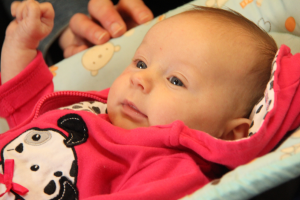
At birth, vision is the least developed of the senses. The brain and eye structures needed for accurate vision are not yet developed.
Newborn visual acuity is very low—the world is very fuzzy and not particularly colorful to them. This is why infants prefer visual images with black and white patterns and high contrast.
But the structures that support visual perception grow very fast. By 2 months, infants can focus on objects as well as adults. By 6 months, they have around 20/80 vision. And by 4 years, they have full 20/20 vision.
Visual Sensitive Period
Visual development in the first 6 months of life is very important for later visual development. The first 6 months are called a sensitive period.
A sensitive period is a period when a child is more sensitive to specific experiences. During this period, those experiences can cause important changes in the child’s development.
For example, infants born with cataracts in both eyes cannot see clearly due to the cloudiness of the cataracts blocking the lenses in their eyes. If infants born with cataracts receive corrective surgery between 4 and 6 months, they show improvement in all aspects of vision except for some aspects of face processing.
The first 4 months of life are considered a sensitive period for visual perception and face processing in particular. Children need visual experiences to provide input to the cerebral cortex during that time to develop accurate face processing later in life.
Face Processing
Face processing is particularly important for infants since it contributes to their ability to engage with their parents and other caregivers.
From birth, infants seek out patterned visual images in the environment, including faces. Even newborns prefer to look at facial images that are arranged right-side up rather than upside-down. Amazingly, scientists have found that, despite infants’ low visual acuity, by 2 months of age, they recognize and prefer their own mother’s face to that of another woman.
Perceptual Narrowing
The first 4 to 6 months are not only a sensitive period during which specific visual input supports the development of brain areas for later visual perception, but they are also a time during which children’s visual perception is attuning to their local environment. This process is called perceptual narrowing.
Again, as newborns, infants perceive all faces similarly. However, by 2 months, infants have already developed a preference for their own mother’s face over other women’s faces.
By 3 to 6 months of age, this preference extends to members of their own race. (Note that is mostly the case for infants primarily exposed to a single race during this time.)
These infants are also better able to discriminate faces of members of their own race, than faces of members of other races. In other words, they can tell the difference between two people of their own race better than they can tell the difference between two members of an unfamiliar race.
Perceptual narrowing also occurs in other areas of development, such as auditory development.
Vroom Tip
Check out this Vroom tip to get more ideas about how to support visual development.
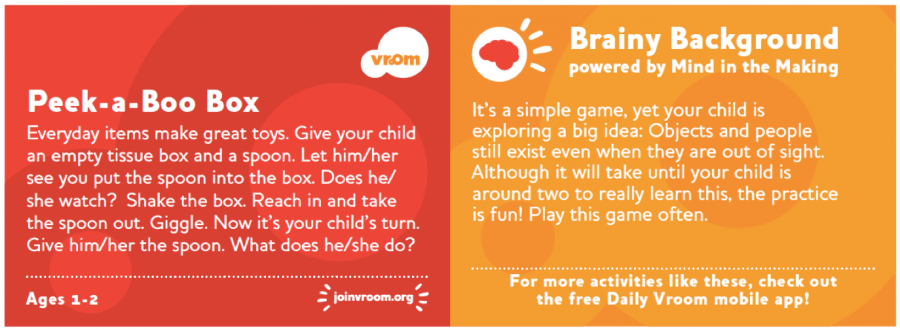
View text-only alternative of this Vroom card
Peek-a-Boo Box
Everyday items make great toys. Give your child an empty tissue box and a spoon. Let him/her see you put the spoon into the box. Does he/she watch? Shake the box. Reach in and take the spoon out. Giggle. Now it’s your child’s turn. Give him/her the spoon. What does he/she do?
Ages 1-2
Brainy Background powered by Mind in the Making
It’s a simple game, yet your child is exploring a big idea: Objects and people still exist even when they are out of sight. Although it will take until you child is around two to really learn this, the practice is fun! Play this game often.
What do you think of this idea? Does this tip make sense in the context of an early learning program environment? And if not, how might you adapt the activity to better fit that environment?
B – Auditory Development
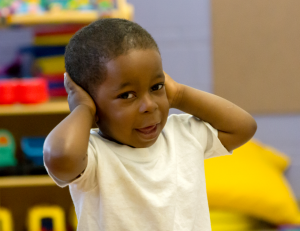
Like visual perception, auditory perception—or hearing—develops rapidly in the first year of life.
However, unlike visual perception, the development of auditory perception is already well underway when an infant is born. Newborn infants are able to hear and distinguish a variety of sounds. In fact, this responsiveness to sounds helps motivate very young infants to explore their environment.
Infants as young as 3 days old will turn to face the direction of a sound, prefer the sound of their mother’s voice to other people’s voices, and prefer the sound of their native language.
By 1 year, infants will have developed a sense of musical phrasing and the ability to distinguish different melodies and can recognize the same melody when it is played in different keys.
Auditory Sensitive Period
Much like visual perception, auditory perception also goes through a fine-tuning process of perceptual narrowing during a sensitive period. The sensitive period for auditory perception occurs around 6 to 12 months of age.
Before the perceptual narrowing occurs, infants are able to hear differences in sounds that adults in their culture cannot. For example, 6-month-olds can detect rhythmic disruptions in music from their own culture and that of other cultures, while adults who are not musically trained in another culture’s musical rhythms are not able to do this.
And newborns can discriminate almost any speech sound in the world. Infants are born universal language learners and gradually attune their hearing to the language or languages they are most often exposed to.
Between 6 and 8 months, infants begin to tune in to the dominant language sounds in their environment and can no longer discriminate sounds in other languages.
By 12 months, babies are also no longer able to detect disruptions in foreign music rhythms, while their detection of disruptions in the dominant music in their environment remains.
Singing and Music
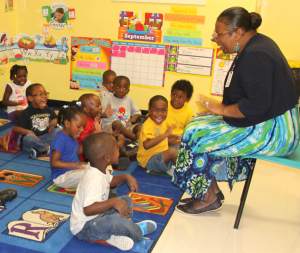
It appears that caregivers around the world take advantage of infants’ skills in auditory perception. The presence of music in caregiving is considered universal, occurring in cultures across the globe.
Lullabies are the most common form of adult-child musical engagement and are readily distinguished from other forms of music by adults across cultures.
There are three components to lullabies that help to distinguish them from other forms of music:
- High pitch
- Slow tempo
- Warm tone
Singing has even been found to be more soothing to infants than mother’s speech sounds and is very effective at affecting infants’ arousal levels, both high and low.
C – Object Exploration, Reaching, and Grasping
Object Exploration
Perception is not just for passively taking in information from the world. Children also use their perceptual experiences to actively explore objects, including tactile (touch), taste, sight, and sound.
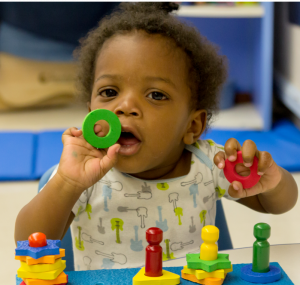
Through the mouth, the child will be able to taste, smell, and feel the texture and density of an object. In early infancy, infants primarily explore using their mouth. This action is called mouthing. Infants’ arms and hands lack both the strength and the coordination to support substantive object exploration. Infants’ mouths are one of their strongest and most reliable sensory organs at this point.
So while this may at times appear unsanitary or simply unappealing to adults, providing infants with safe spaces in which they can eagerly explore varied objects through their mouths is a great way to enrich their early childhood experiences.
Reaching
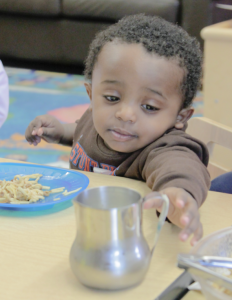
In particular, as infants’ skill in reaching improves around 5 to 6 months of age, this frees up their vision for controlling other behaviors such as grasping. As children develop their ability to reach for an object with their arms and grasp it with their hands, they will shift from mouthing objects to exploring them using their eyes, ears, and fingers.
Scientists have studied this shift in visual control by switching off the lights when infants reach for an object. They then observe whether the infant continues to reach successfully or not. If the infant can reach successfully even when the lights are turned off, this suggests that the infant no longer relies on visual guidance when reaching for an object. Thus, this infant can now use visual input for other tasks, such as planning how to effectively grasp an object that it has reached for.
Grasping
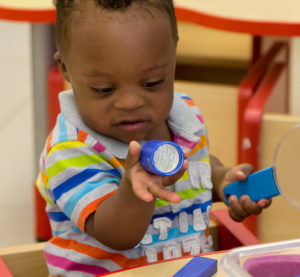
Before 4 months, infants have a difficult time intentionally manipulating objects with their hands. They have difficulty letting go of objects when they want to. They are unable to pass an object from one hand to the other. They also have a hard time shaping their hands and orienting them in a way that would be effective to grasp objects. For example, they might reach for a large object with a small grasp opening.
By 4 to 5 months of age, infants have begun to develop a clumsy, but at least intentional and adjusted, fingers-to-palm grasp (called an ulnar grasp). They have also begun to develop the ability to pass an object from one hand to the other to see its different sides and more effectively explore its properties.
By 12 months, infants are able to use a more precise and coordinated grasp (called a pincer grasp) to effectively pick up and explore objects.

Reflection Point
Think an object that you think young children of different ages (from birth to age 5) would explore differently and describe how you think the children might explore the object and what they might discover. If you can’t think of an object, consider one of these:
- block
- toothbrush
- ball
What perceptual abilities would a child at each age would use to explore the object? What are different properties of the object that a child at each age might discover?
View example. (Click to toggle expand or collapse.)
Someone could pick a toy block that makes sound when shaken. Children at earlier ages—for example, infants—might not discover the sound-making properties of the object, although they may learn about the block’s plastic flavor and texture with their mouth. Older children might notice the weight of the block, the sound it can make, its color, or its shape.
D – Action Guidance
Although their roles shift throughout development, visual and auditory perception are both key components of how children guide their own actions, such as grasping, reaching, and whole body movements through space. This process is called action guidance.
For example, infants can use auditory cues to localize an object and visual cues to adjust the size and strength of their grasp for exploration. Infants are using their perceptual abilities (sight and sound) to guide their actions (adjusting size and strength of their grasp).
Children use their developing perceptual abilities for two primary components of action guidance:
- Object localization
- Object identification
Children can look for, listen for, or smell for an object to find out its location. Once they have the object, they can use a variety of senses to explore what that object is and how to handle it.
Body Movement
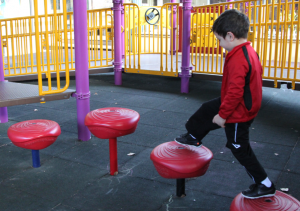
Children use their perceptual skills to orient their bodies in space to avoid obstacles or approach objects. As children develop, many of these skills become less reliant on visual or auditory perception and more on proprioception— one’s perception of their movement and spatial orientation based on internal body cues. One of the most prominent forms of action guidance that perceptual skills contribute to is body movement.
For example, 3-year-olds use visual input to plan out how to place their legs on uneven ground, such as stairs. By 4 years, this dependency on visual input has significantly declined, and by adulthood, people no longer require visual input to plan out leg placement when going up or down stairs.
Object Tracking
Infants not only rely on visual and auditory cues for body movement but also to identify and track objects of interest.
Before 4 months, if infants see two objects move together or touch, they have a hard time distinguishing them as two separate items.
By 4 months though, infants have begun to use features, such as shape, color, or pattern, to distinguish two touching objects. Infants are also initially very attracted to movement of any kind, especially when accompanied by interesting sounds.
One complication of object movement is when objects disappear completely or are partially behind other objects. If an object moves partially behind another object, it appears to break into two separate items.


Video: The Spinner Toy (2:08)
When you watch the following video, think about these questions:
- How do the two infants perceive this object? What does it look like, feel like, and sound like?
- What kinds of object exploration do you notice? Grasping, mouthing, reaching?
- How would you interact with infants using this object?

Video Debrief
What did you notice in the video about the toy and the infant? (click to toggle expand or collapse)
Some things we noted are:
- The movement of the object, as well as its sound, captures the infants’ attention. The top of the toy is also textured, which provides a tactile experience.
- The handle for the object also has a high contrast, with a white stem against the red of the top knob.
- The infants’ use of grasping, reaching, and mouthing.
 References
References
Amso, D., & Johnson, S. (2006). Learning by selection: Visual search and object perception in young infants. Developmental Psychology, 42(6), 1236.
Bar-Haim, Y., Ziv, T., Lamy, D., & Hodes, R. (2006). Nature and nurture in own-race face processing. Psychological Science, 17(2), 159–163.
Bartrip, J., Morton, J., & Schonen, S. (2001). Responses to mother’s face in 3‐week to 5‐month‐old infants. British Journal of Developmental Psychology, 19(2), 219–232.
Berk, L. (2013). Child development (9th ed.). Boston, MA: Pearson.
California Department of Education. (2016). Perceptual and Motor Development Domain: California Infant/Toddler Learning & Development Foundations [0-36 months]. [Website]
Cowie, D., Atkinson, J., & Braddick, O. (2010). Development of visual control in stepping down. Experimental Brain Research, 202(1), 181–188.
Cultivate Learning (Producer). (2017). The spinner toy. University of Washington. [Video File]
Maurer, D., Mondloch, C. J., & Lewis, T. L. (2007). Effects of early visual deprivation on perceptual and cognitive development. Progress in Brain Research, 164, 87–104.
Maurer, D., Lewis, T. L., & Mondloch, C. J. (2005). Missing sights: Consequences for visual cognitive development. Trends in Cognitive Sciences, 9(3), 144–151.
McCarty, Michael E., & Ashmead, Daniel H. (1999). Visual control of reaching and grasping in infants. Developmental Psychology, 35(3), 620 –31.
Shenfield, T., Trehub, S., & Nakata, T. (2003). Maternal singing modulates infant arousal. Psychology of Music, 31(4), 365–375.
Trehub, S. E., & Trainor, L. (1998). Singing to infants: Lullabies and play songs. Advances in Infancy Research, 12, 43–77.
U.S. Department of Health and Human Services, Administration for Children and Families, Office of Head Start. (n.d.). Head Start Early Learning Outcomes Framework: Ages birth to five. [PDF]
Viola Macchi, C., Turati, C., & Simion, F. (2004). Can a nonspecific bias toward top-heavy patterns explain newborns’ face preference? Psychological Science, 15(6), 379–383.
Vroom. (2017). Tools and resources. [Website]
EarlyEdU Alliance (Publisher). (2018). 3-1 Perception. In Child Development: Brain Building Course Book. University of Washington. [UW Pressbooks]
A sensitive period is a period when a child is more sensitive to specific experiences. During this period, those experiences can cause important changes in the child’s development.

